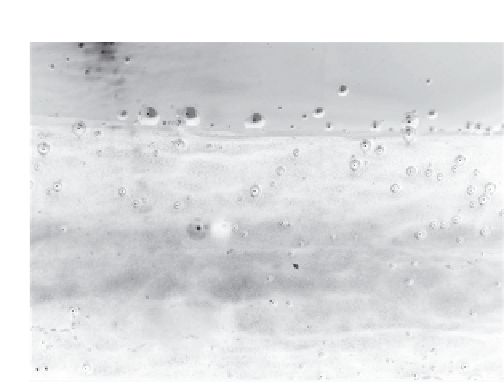Agriculture Reference
In-Depth Information
US grade standards for greenhouse cucumbers are less
stringent than Canadian standards and are written specifi-
cally for European seedless types, specifying only a mini-
mum length (279 mm) (USDA 1985).
The Codex Alimentarius Commission (CAC) was estab-
lished in 1963 by FAO and WHO of the United Nations,
with the goals to protect consumer health, ensure fair trade
practices and assist in coordination of food standards by
individual governments and nongovernmental organiza-
tions (CAC 2002). The Commission publishes reports,
hosts meetings and maintains standards relevant to foods
and drugs. Other grade standards are available online,
including Australia and New Zealand (http://www.
foodstandards.gov.au) and Japan (http://www.maff.go.jp/
eindex.html).
Figure 14.12
Submerging a Beit Alpha cucumber
and pulling a slight vacuum draws air from
intercellular spaces, revealing open lenticels in the
epidermal tissue.
Flavour and Aroma
Flavours and aromas associated with cucurbit types are
composed of complex interactions between sugars, acids
and aroma volatiles, which in turn are impacted by pre-
harvest conditions, fruit maturity and storage environ-
ment. For example, starches degraded and sucrose
accumulated prior to harvest of buttercup squash (Irving
et al
. 1997) and during ripening of 'Galia' melon
(McCollum
et al
. 1988). The sweeter flavour attributed to
'Galia' melon may be due to the lower acidity than other
specialty melons. Artes
et al
. (1993) reported 'Galia' to
have a soluble solids content of 10.8 °Brix, similar to that
for three other melon types ('Piel de Sapo', 'Amarillo' and
'Tendral'), but 'Galia' had a total titratable acidity of
0.054 (% citric acid), 50% to 75% lower than the other
cultivars (see Table 14.7). Sugar concentrations in placen-
tal tissue decreased during storage of 'Charleston Gray'
watermelon as a function of increased storage temperature
(Chisholm and Picha 1986).
No starch reserves are present in cantaloupe that can be
converted to sugars (Bianco & Pratt, 1977). However,
significant variability in flavour has been reported due to
cultivar. Some cantaloupe cultivars lost sugars during stor-
age, while others maintained them (Cohen & Hicks, 1986).
Highest aroma volatile concentrations were found in
'Galia' melons harvested with yellow background colour
and slight green areas, a ripeness stage that permits
transport to distant markets while maintaining high quality
(Fallik
et al
. 2001).
epicuticular waxes, conversion of sugars to starches, loss
of acids, decreased production of aroma volatiles and
eventual development of off-flavours and aromas due to
fermentation processes.
Moisture loss
Immature-harvested fruits, such as yellow summer squash,
are much more perishable during post-harvest handling
than those harvested mature for several reasons. Immature
fruits generally have a thin epidermis and partially formed
epicuticular wax, making them more susceptible to mois-
ture loss and decays. These also have higher moisture
contents in the edible portion than mature fruits (see
Table 14.6). Open lenticels, stem-end and blossom-end
scars are the primary points of gas exchange, and shrivel
symptoms generally first appear at the stem end which
has the highest gas exchange rate (Figure 14.12). For this
reason protective coatings are often applied to immature
cucurbits prior to marketing.
The correlation between weight loss and appearance
varies widely between cucurbits. For instance, weight loss
of 7% during storage was judged as the limit of marketabil-
ity for cucumber appearance (Kang
et al
. 2002), whereas
shrivel symptoms became apparent on unwaxed, yellow-
crookneck summer squash following 18% weight loss and
were moderate by 24% weight loss (Hrushka 1977).
Summer squash types (vegetable marrow, zucchini and
scallop) became unacceptable from 6 to 20 days storage at
5
Senescent processes and environmental factors
Senescent processes occur during storage and handling
of cucurbits and are characterized by softening, loss of
cellular integrity, breakdown of chlorophyll, breakdown of
C and 85% relative humidity, with those having the
Gene B (yellow epidermal pigmentation) being most
°






























